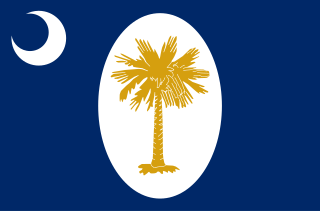| |||||
| Decades: | |||||
|---|---|---|---|---|---|
| See also: | |||||
Events from the year 1861 in the United States. This year marked the beginning of the American Civil War.
| |||||
| Decades: | |||||
|---|---|---|---|---|---|
| See also: | |||||
Events from the year 1861 in the United States. This year marked the beginning of the American Civil War.







The Confederate States of America (CSA), commonly referred to as the Confederate States (C.S.), the Confederacy, or the South, was an unrecognized breakaway republic in the Southern United States that existed from February 8, 1861, to May 9, 1865. The Confederacy comprised eleven U.S. states that declared secession and warred against the United States during the American Civil War. The states were South Carolina, Mississippi, Florida, Alabama, Georgia, Louisiana, Texas, Virginia, Arkansas, Tennessee, and North Carolina.
1861 (MDCCCLXI) was a common year starting on Tuesday of the Gregorian calendar and a common year starting on Sunday of the Julian calendar, the 1861st year of the Common Era (CE) and Anno Domini (AD) designations, the 861st year of the 2nd millennium, the 61st year of the 19th century, and the 2nd year of the 1860s decade. As of the start of 1861, the Gregorian calendar was 12 days ahead of the Julian calendar, which remained in localized use until 1923.

The Battle of Fort Sumter was the bombardment of Fort Sumter near Charleston, South Carolina by the South Carolina militia. It ended with its surrender by the United States Army, beginning the American Civil War.

In the American Civil War (1861–65), the border states or the Border South were four, later five, slave states in the Upper South that primarily supported the Union. They were Delaware, Maryland, Kentucky, and Missouri, and after 1863, the new state of West Virginia. To their north they bordered free states of the Union, and all but Delaware bordered slave states of the Confederacy to their south.

Nathaniel Lyon was a United States Army officer who was the first Union general to be killed in the American Civil War. He is noted for his actions in Missouri in 1861, at the beginning of the conflict, to forestall secret secessionist plans of the governor Claiborne Jackson.

Claiborne Fox Jackson was an American politician of the Democratic Party in Missouri. He was elected as the 15th Governor of Missouri, serving from January 3, 1861, until July 31, 1861, when he was forced out by the Unionist majority in the legislature, after planning to force secession of the state.

The Camp Jackson affair, also known as the Camp Jackson massacre, occurred during the American Civil War on May 10, 1861, when a volunteer Union Army regiment captured a unit of secessionists at Camp Jackson, outside the city of St. Louis, in the divided slave state of Missouri.
During the lead-up to the American Civil War, the proposed secession of Missouri from the Union was controversial because of the state's disputed status. The Missouri state convention voted in March 1861, by 98-1, against secession, and was a border state until abolishing slavery in January 1865. Missouri was claimed by both the Union and the Confederacy, had two rival state governments,, and sent representatives to both the United States Congress and the Confederate Congress.

Alabama was central to the Civil War, with the secession convention at Montgomery, the birthplace of the Confederacy, inviting other slaveholding states to form a southern republic, during January–March 1861, and to develop new state constitutions. The 1861 Alabaman constitution granted citizenship to current U.S. residents, but prohibited import duties (tariffs) on foreign goods, limited a standing military, and as a final issue, opposed emancipation by any nation, but urged protection of African-American slaves with trials by jury, and reserved the power to regulate or prohibit the African slave trade. The secession convention invited all slaveholding states to secede, but only 7 Cotton States of the Lower South formed the Confederacy with Alabama, while the majority of slave states were in the Union. Congress had voted to protect the institution of slavery by passing the Corwin Amendment on March 4, 1861, but it was never ratified.

South Carolina was the first state to secede from the Union in December 1860, and was one of the founding member states of the Confederacy in February 1861. The bombardment of the beleaguered U.S. garrison at Fort Sumter in Charleston Harbor on April 12, 1861, is generally recognized as the first military engagement of the war. The retaking of Charleston in February 1865, and raising the flag again at Fort Sumter, was used for the Union symbol of victory.

The American state of Virginia became a prominent part of the Confederacy when it joined during the American Civil War. As a Southern slave-holding state, Virginia held the state convention to deal with the secession crisis and voted against secession on April 4, 1861. Opinion shifted after the Battle of Fort Sumter on April 12, and April 15, when U.S. President Abraham Lincoln called for troops from all states still in the Union to put down the rebellion. For all practical purposes, Virginia joined the Confederacy on April 17, though secession was not officially ratified until May 23. A Unionist government was established in Wheeling and the new state of West Virginia was created by an act of Congress from 50 counties of western Virginia, making it the only state to lose territory as a consequence of the war. Unionism was indeed strong also in other parts of the State, and during the war the Restored Government of Virginia was created as rival to the Confederate Government of Virginia, making it one of the states to have 2 governments during the Civil War.

Charleston, South Carolina, was a hotbed of secession at the start of the American Civil War and an important Atlantic Ocean port city for the fledgling Confederate States of America. The first shots against the Federal government were those fired there by cadets of the Citadel to stop a ship from resupplying the Federally held Fort Sumter. Three months later, the bombardment of Fort Sumter triggered a massive call for Federal troops to put down the rebellion. Although the city and its surrounding fortifications were repeatedly targeted by the Union Army and Navy, Charleston did not fall to Federal forces until the last months of the war. Charleston was devastated.

Thomas Caute Reynolds was the Confederate governor of Missouri from 1862 to 1865, succeeding upon the death of Claiborne F. Jackson after serving as lieutenant governor in exile. In 1864 he returned to the state, but was forced back into exile after the Battle of Westport.

During the American Civil War, Arkansas was a Confederate state, though it had initially voted to remain in the Union. Following the capture of Fort Sumter in April 1861, Abraham Lincoln called for troops from every Union state to put down the rebellion, and Arkansas and several other states seceded. For the rest of the civil war, Arkansas played a major role in controlling the Mississippi River, a major waterway.

Louisiana was a dominant population center in the southwest of the Confederate States of America, controlling the wealthy trade center of New Orleans, and contributing the French Creole and Cajun populations to the demographic composition of a predominantly Anglo-American country. In the antebellum period, Louisiana was a slave state, where enslaved African Americans had comprised the majority of the population during the eighteenth-century French and Spanish dominations. By the time the United States acquired the territory (1803) and Louisiana became a state (1812), the institution of slavery was entrenched. By 1860, 47% of the state's population were enslaved, though the state also had one of the largest free black populations in the United States. Much of the white population, particularly in the cities, supported slavery, while pockets of support for the U.S. and its government existed in the more rural areas.
The Missouri Constitutional Convention of 1861–1863 was a constitutional convention held in the state of Missouri during the American Civil War. The convention was elected in early 1861, and voted against secession. When open fighting broke out between Pro-Confederate governor Claiborne Fox Jackson and Union authorities, and Union forces occupied the state capital, the convention formed a provisional state government, and functioned as a quasi-legislature for several years. The convention never did produce a new constitution; that task was delegated to a new convention, elected in 1864.

William Yarnel Slack was an American lawyer, politician, and military officer who fought for the Confederate States of America during the American Civil War. Born in Kentucky, Slack moved to Missouri as a child and later entered the legal profession. After serving in the Missouri General Assembly from 1842 to 1843, he fought as a captain in the United States Army for fourteen months during the Mexican–American War, beginning in 1846. He saw action at the Battle of Embudo Pass and the Siege of Pueblo de Taos. Returning to a legal career, Slack became influential in his area.
Events from the year 1862 in the United States.
Events from the year 1863 in the United States.
Events from the year 1865 in the United States. The American Civil War ends with the surrender of the Confederate States, beginning the Reconstruction era of U.S. history.